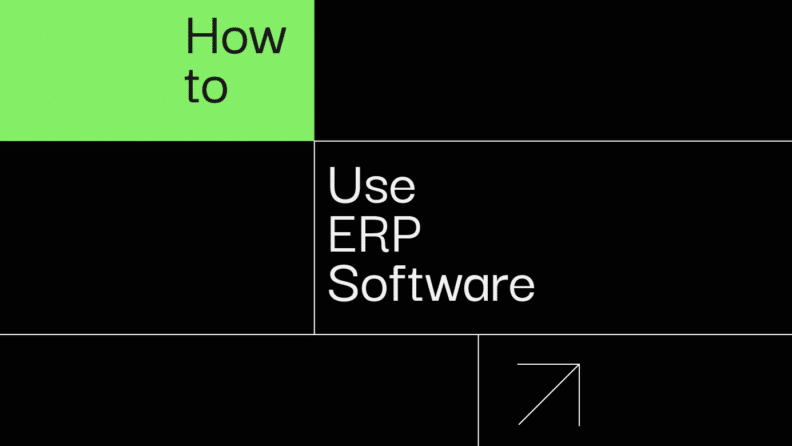Unfortunately, you read that correctly - according to Gartner, "55-75% of ERP projects fail or don't meet their intended objectives."
Considering the time and capital that goes into ERP implementation, as well as the benefits that ERP software offers businesses, this is a huge (and disappointing) statistic.
A 2019 report showed that over half of all businesses were planning to upgrade their current enterprise resource planning (ERP) system or implement a new one shortly. Learning how to use ERP software becomes critical for finance professionals and leaders as an increasing number of companies choose to use it in their workplace.
As a CFO, an enterprise resource planning system is one of your most powerful tools. A combination of automated transaction re-entry, real-time data, and customizable dashboards allows you to leverage a comprehensive understanding of your company’s financial health and needs.
What Is ERP Software?
The central goal of ERP is to provide a system of integrated and centralized applications that cover the essential business needs of all your most crucial departments. For example, as a CFO, you may benefit most from the accounting, analytics, and general finance modules you may find in a given solution.
But you aren’t the only one that will end up happy; other departments will also significantly benefit from ERP implementation. For example, most ERP software features key capabilities required for human resources, supply chain management, and other departmental needs.
ERP software commonly falls into one of three tiers based on its robustness and ideal use cases.
- Tier 1: These ERPs are best for large and complex multinational organizations. Generally, Tier 1 ERP users have more than 1,000 employees and an annual revenue of $500 million or more. Tier 1 systems come with hefty price tags but they also offer extremely robust solutions and configurations to fit most business scenarios. The best-known Tier 1 ERPs include SAP and Microsoft Dynamics 365.
- Tier 2: For mid-market and growing businesses, Tier 2 ERPs can be a good solution. Not only can they be implemented faster than Tier 1 solutions, but they also come at a lower price point. Oracle NetSuite and Sage Intacct are Tier 2 solutions that can be a good fit for businesses with less than 1,000 employees and a limited geographic spread.
- Tier 3: Compared to previous ERP tiers, Tier 3 solutions exist to solve issues for very niche industries, such as food production or pharmaceutical manufacturing. These solutions tend to be lighter on some functionalities, such as project management, while focusing on the things that these businesses need most. They are typically less expensive to license than the higher tiers. For example, Quickbooks is an example of a Tier 3 solution.
What Should An ERP System Be Used For?
There are many real-world use cases for ERP systems, allowing you to do things such as:
- Automate tedious routine tasks to save time.
- Improve your company’s business performance by improving organizational policies and tools.
- Streamline workflows by supporting better communication and collaboration while ensuring everyone has the tools they need to complete their jobs effectively.
- Increase profitability through time savings and better accounting software capabilities.
- Receive more in-depth data to help with procurement, forecasting, material requirements planning, etc.
- Increase business scalability to facilitate growth (especially for small businesses).
- Manage inventory effectively and streamline business functions.
- Improve decision-making, lead capture, and lead conversion in sales and marketing.
- Improve human resource management by connecting your employee database with other reporting and action features.
- Use business intelligence to make data-driven decisions on crucial topics.
However, it’s important to note that an enterprise resource planning system isn’t a solution for all your company’s issues. An ERP won't get a struggling company out of a deficit quickly. In fact, it can have the opposite effect. Licensing costs can be upwards of $20,000 per year (on the cheaper end of the spectrum) and most implementations require the assistance of specialized, and costly, firms.
What Types of ERP Systems Will I Encounter?
There are three potential ERP system hosting types that you’ll be able to choose from, each with its distinct advantages and disadvantages. These include on-premises, cloud-based, and hybrid ERP types.
On-Premises ERP
An on-premises ERP comes at the cost of a large upfront licensing fee and ongoing maintenance. Plus, you’ll need the necessary hardware because these ERPs are hosted on your computers and servers, in your facility. The upside of these enterprise resource planning systems is maximum customization and unrivaled data security. However, they aren’t affordable for every company and require highly knowledgeable in-house technical resources.
Cloud-Based ERP
Cloud-based ERPs are purely a software-as-a-service (SaaS) model, where you pay a subscription fee for usage over a specific period (monthly, quarterly, or yearly). The software is hosted on the vendor’s computers, and your company accesses it online. While cloud-based ERPs are generally more affordable than on-premises solutions, their long-term price point is harder to calculate and their data security may not be as stringent.
Hybrid ERP
A hybrid ERP combines elements of both cloud-based and on-premises ERP solutions. The advantages and disadvantages vary based on which aspects of each hosting type are used.
How to Use ERP Software
Regardless of the type chosen, purchasing ERP software is a significant investment for your company in terms of both time and capital — investments you can’t afford to waste. To reap the greatest benefits of ERP software, you’ll want to know how to use it effectively. Follow the steps below to get the most significant benefits from your new ERP system.
Review Business Processes
Which business processes need the most improvement? What problems are you trying to solve by introducing an ERP platform into your company? These are crucial questions to ask yourself when choosing the right ERP for your company.
You can answer these questions by conducting a complete overview of your company’s current business management, processes, and metrics (both company-wide and department-specific). Once you’ve identified any weak spots that could use improvement, create a report you can reference later to assess the viability of the new ERP you choose.
Focus on Data Quality
Your new ERP software system will provide a lot of valuable data that can help you make more informed business decisions. But for it to be fully accurate, you’ll need to spend some time fine-tuning the types of data your new system generates. You’ll want to pay extra attention to the financial reporting section.
You should also ensure other departments in your company set their data preferences appropriately. It’s a good idea to hold an executive team meeting to discuss what accurate data parameters look like before diving in. Setting up data parameters is much easier than fixing them after a mistake is made.
Customize Your ERP Software
Unless you’ve decided to open the vaults for a fully custom-built ERP, you’re going to be looking at an out-of-the-box solution or an onboarding process with a choice of many various modules.
You’ll want to analyze the modules included, decide which you’re going to use, and then customize the module options to suit your company’s unique needs. As the CFO, you’ll want to focus specifically on the billing, accounting, inventory, and purchasing modules. I’ve created a checklist below of some of the most important aspects to take care of before your first ERP use.
Billing
- Set up your invoicing options (and remember to customize your company’s invoices to fit your branding).
- If you’re in e-commerce, ensure that your company’s website is connected to your billing system.
- Ensure all appropriate back-office employees have access to billing and payment information.
- Automate routine tasks, like billing follow-up emails or recurring charges.
Accounting
- Customize your accounts payable section as necessary.
- Fine-tune your financial data and analytics reporting.
- Check your company’s financial statements to ensure they contain all the necessary information to be GAAP or IFRS-compliant.
Inventory
- Determine whether you want to use an ERP integration to connect with existing inventory management software or if you want the ERP to replace this software.
- Customize your order management dashboard.
- Customize how spreadsheets will be produced when pulled for review.
- If an e-commerce business, ensure current inventory is linked to your live sales.
Purchasing
- Ensure vendor tracking is set up and customize fields as necessary.
- Ensure purchasing is incorporated into operating costs reports.
- If you have a physical product, link inventory and purchasing so you know exactly when relevant purchases need to be made.
ERP Usage - Best Practices
If you've followed the steps above, you're going to create a comprehensive ERP system that will benefit your team; however, you need to ensure that the implementation, adoption, and longevity of the system are also considered.
Here are some of the biggest things to track if you want to ensure long term ERP success.
Future-Proof Your ERP Software
The ERP your company needs today may not be the same one you need in 5 years. This means you should be looking for an enterprise resource planning system that will grow and change with your company — not remain stagnant and become outdated.
It’s easiest to ascertain whether your ERP software has been future-proofed by asking questions before your initial purchase. Speak with a vendor representative and ask the following questions:
- What new features are being planned or produced? When can I expect those new features to launch?
- What does the vendor’s roadmap look like in the near term? Long term?
- How often is the software updated?
- Do the vendor plan to add more integrations or customization options in the future?
A good ERP vendor should be able to answer these questions in detail. You’ll want to hear that the vendor has many future improvements planned. You’ll also want to use an ERP with regular software updates for compliance and data security.
Integrate With Existing Systems
If you have systems you plan to continue using after your ERP implementation, make sure they can be integrated. For example, if you aren’t replacing them outright with your ERP, you may want to integrate your existing customer relationship management (CRM) system, supply chain management system, or marketing software.
Make It Easy to Use
One excellent way to make your ERP system easy to use is by leveraging mobile apps. Today, people like to have everything at their fingertips — for business and personal use. Ensuring your ERP software can be used on mobile devices makes it easier for all involved stakeholders.
Define Other Stakeholders
Training is something that you can’t afford to overlook (but many companies do). Approach training in a hierarchical fashion, identifying key stakeholders within specific departments and training them in order to equip them to train all other employees.
Monitor Cost-Savings and ROI
As the CFO, you’re going to want to systematically analyze financial savings from implementing new technologies, and the data mined from your new ERP can help. Using the data from before implementation, see how many labor hours and resources were used to accomplish specific tasks. Compare that to the time spent since implementing your ERP to identify how much time has been saved and thus, the ongoing marginal benefit that your company can enjoy.
Need expert help selecting the right ERP Software?
We’ve joined up with Crozdesk.com to give all our readers (yes, you!) access to Crozdesk’s software advisors. Just use the form below to share your needs, and they will contact you at no cost or commitment. You will then be matched and connected to a shortlist of vendors that best fit your company, and you can access exclusive software discounts!
Make ERP Software Work For You
Proper implementation of ERP software has the power to push your business forward, into a future where steady growth and increasing profits are a reality. Your company can reap the benefits of cost savings, profit increases, streamlined processes, better communication, improved collaboration, and so much more.



